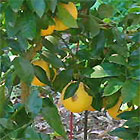Don looked at some ‘must do jobs’ for spring.
Repot now
Over the next few weeks plants will make about 90-95% of their growth for the year, so repot any plants that need it now.
Repot any plants that have been in the same pot for two years or more. This is necessary even if the plant has not outgrown its pot, because the potting mix degenerates (it shrinks, becomes water repellent and runs out of fertiliser) and needs renewing.
Either repot using the same container, or put the plant in a pot about 50-100mm (2-4″) larger in diameter, with extra potting mix.
If the plant is very root-bound, cut off about 25-50mm (1-2″) of solid roots from the bottom and perhaps make two or three vertical slits 10mm (1/2″) deep in the root ball with a knife. Then place the plant in a larger pot.
Partially fill the pot with potting mix so the plant sits at the correct level. Centre the plant in the pot. Fill around the root ball with more mix, taking care not to build the soil up around the trunk.
Water well after repotting. Good quality potting mixes contain fertiliser, but at this stage it is okay to add a slow-release fertiliser, such as Osmocote for pots. If you’re in a drought affected area add a soil wetting agent, such as SaturAid, so that when the plant dries out it’s rewettable.
After repotting, particularly if you have trimmed the roots, the plant should be placed in a semi-shaded area for a few weeks to re-establish. After that it can be put back in full sun or wherever it is happiest.
Fertilise citrus
Mid spring when citrus crops are finishing and new growth is appearing is the time to fertilise citrus. As they are similar in composition to rose foods, citrus food can be fed to roses and vice versa. Citrus and rose foods can be used to fertilise vegetables, too. Chook poo (such as Dynamic Lifter) is also good for citrus. Alternate between citrus food and a general fertiliser such as Dynamic Lifter. Use one in spring and the other in late summer.
To fertilise a full grown citrus tree spread about 1.5-2 cups of citrus food under the tree to the drip line, where the feeder roots are found. The drip line is the line of the outer edge of the branches where the drips from foliage would fall. Water well after applying fertiliser. Citrus in tubs need small amounts of food frequently. Either fertilise every 4-6 weeks from spring to late summer with a small amount of Dynamic Lifter or citrus food, or use a slow-release fertiliser such as Osmocote Plus.
Note:
if you are in a drought area delay fertilising until the drought is over.
Grow edibles in containers
Spring is a great time to plant edibles such as herbs and salad greens. Don’s tip is to grow them in containers, so that you’ll be able to water them even if your area is drought affected.
Start with pots and troughs large enough to hold the plants and provide enough room between them so that they can spread to their mature width. (Tip: make sure there are holes in the bottom of the containers. If not, drill some, starting with a small drill bit then moving to a larger bit.)
Fill the containers with a good quality potting mix. This will supply essential nutrients to keep your greens growing steadily. (Tip: never use a cheap potting mix. Quality potting mixes display the Standards Australia ‘ticks’ on the pack.)
If sowing seed, cover the seeds lightly with 2-3mm of seed raising mix, firm down and keep moist until after germination.
If using seedlings, water the plants in their containers half an hour before planting. Remove the plant from its container, taking care not to damage the roots. Make a hole for the plant in the potting mix and allow enough room to ensure that you don’t squash the roots when planting. Place in the hole and firm the potting mix around the plant.
Keep well watered while establishing and feed about once a fortnight with a liquid fertiliser, such as Thrive or Nitrosol.
Harvest as required.
Further information
Punnets of herbs cost $3 – $5.
Good quality potting mix costs about $10 – $15 for a 30 litre bag.
500g SaturAid wetting agent costs about $10.
8kg bag of citrus fertiliser costs about $15.



